TMJ Technology
Use these links to learn more about different aspects of TMJ Technology:
- JVA (Joint Vibration Analysis)
- Measuring Jaw Movement
- Measuring Muscle Activity
- Recording Jaw Joint Sounds
TM Joint Vibration Analysis
TM Joint Vibration Analysis is a quick, non-invasive method for your dentist to examine how your jaw joints function. The vibration from each patient is like your own personal signature--determined by loudness, duration and frequency.
Our office uses a device called Joint Vibration Analysis (JVA) to help determine if patients have a TM joint (jaw joint) problem. Joint Vibration Analysis has the acceptance of the American Dental Association. The dentist has the primary responsibility for diagnosing disorders of this particular joint. Utilizing the JVA procedure aids the dentist in making an accurate diagnosis and demonstrates the severity level of the disorder.
About the TM Joint
The Temporomandibular Joint--TMJ--consists of bone, cartilage and ligaments. Like most joints, the TM joint functions best when these parts are in proper relationship to each other. Just as the shoulder or hip can become displaced, so can the TM joint.
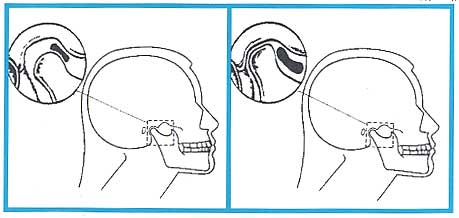
Normal and Displaced TM Joints - (left) Normal TM Joint; (right) Displaced TM Joint
The TM joint can also be affected by arthritic changes - like the knee or elbow joints. Jaw joint disorders may be accompanied by many symptoms including:
- Headaches
- Dizziness
- Neck, shoulder pain
- Jaw pain or soreness
- Worn or cracked teeth
- Difficulty swallowing
- Earaches or ringing
- Limited mouth opening
- Clicking or joint sounds
- Locking jaw
- Sore facial muscles
- Sensitive teeth
TM joint disorder is often progressive. A minor joint sound now may mean major pain down the road, so dental professionals suggest early diagnosis of TM joint problems. This is where the new test, Joint Vibration Analysis, enters in.
What is Vibration Analysis?
Normal TM Joint SignatureWhen you open your mouth, the various parts of the TM joint rub together. When a well-lubricated, healthy joint works normally, this movement generally produces little friction and hence, little vibration or sound. However, when there is a joint problem, the parts rub together in a different way. This motion creates a sound or vibration you may be able to hear, but some vibrations are outside our audible range.
Decades of research show that certain TM joint problems can create a specific type of vibration - almost like a signature. For instance, the "signature" of a normal TM joint might look like the picture to the right.
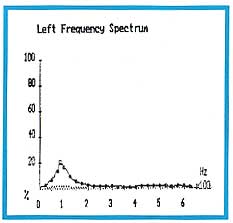
Your "signature" is analyzed by measuring differences in loudness, duration and frequency. This provides information to determine:
- if a joint problem is present
- the nature of the problem
The "signature" of a TM joint with problems or dysfunction might look like this:
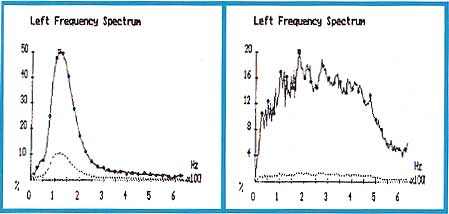
If a TM disorder does exist, the severity can be checked again at the next appointment to see if it is stable, worsening or improving. In fact, your "signature" reading may be redone anytime as a guide to assess the treatment outcome.
How does this test work?
The test is simple, takes 3 to 5 minutes and is painless. A headset is placed over your head (like a stereo headset) with the vibration sensors on the skin over the TM joint in front of each ear.
You will be asked to open wide and close all the way 5 or 6 times. That's all there is to it! Now the computer takes over to provide your specific vibration signature to be evaluated.
Who should have this test?
Anyone may have a TM joint problem. Like most medical conditions, if there is evidence of a TM joint problem, the sooner it is discovered, the better the chance is for successful and less expensive treatment. Joint Vibration Analysis is recommended in these cases:
- Any patient who has or recently had symptoms of TM joint disorder. This includes any pain in the TM joint or jaw muscle; a "catch" in jaw movement or a jaw which deviates to the right or left when opening; a joint sound or sensation; or ringing in the ears.
- Any patient undergoing orthodontic or major prosthodontic (bridge or dentures) treatment. It is important to:
- be sure the TM joint is in good condition before starting an extensive procedure, and
- monitor changes in the joint function during and after treatment.
Our office is excited about this procedure and the diagnostic benefits to our patients. If you have questions about Joint Vibration Analysis that this brochure has not addressed, please feel free to ask our staff.
An informed patient is the best patient. Your dental and overall health is important to us!
Measuring Jaw Movement
For many years, dentists have not had an objective way of measuring jaw movements. Tracking jaw movement is very important, however, to truly understand whether or not your jaw is functioning properly. If your were having heart pains, you certainly would not expect a physician to diagnose your condition by simply feeling your pulse! Likewise, dentists must use sophisticated medical instruments to measure jaw dysfunction.
Computerized electronics have now made it possible for us to have this diagnostic capability in our office. We can now track and record tiny jaw movements with a degree of accuracy far greater than the human eye.
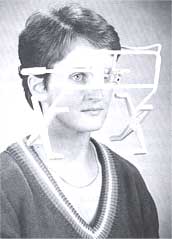
How so? A tiny magnet is placed just below your lower front teeth. The movements of your jaw are tracked through a sensor array, which you wear like a pair of glasses. This transfers the information to a computer which then displays it on a screen so that we now have a "peephole." In other words, we can see exactly how your jaw is moving whether or not your lips are closed. The information is also stored and recorded so that it can be referred to at a later date.
Measuring Muscle Activity
Muscle activity is measured by using an instrument called an electromyograph (EMG). Like TENS, electromyography has been used by various medical specialties for some time. Only recently, however, have dentists begun to appreciate its clinical application.
By taping EMG electrodes over particular muscles of the face, head or neck, we can monitor the amount of tension in these muscles. Muscles operate like tiny batteries in that they give off small electrical currents. When tense, they give off a higher electrical charge. The EMG electrodes pick up this activity and transmit it to an instrument where it is recorded and displayed. Now we have an objective way of measuring how much muscle tension you are experiencing.
We use electromyography in two ways. First, we use it to determine whether or not your muscles are truly relaxed. Second, we are able to see how your muscles work together when functioning (i.e. chewing). Remember that when a malocclusion exists, your muscles must torque to bring the jaw together. By identifying which muscles are working harder, we are able to determine where adjustments need to be made in your bite to relieve these muscles of strain.
We have just described diagnostic procedures based on the most sophisticated technology presently available. Not all dentists have access to all of this instrumentation, but this does not prevent them from diagnosing and treating MPD effectively.
It is also important to keep in mind that when making a diagnosis, dentists are trying to determine the primary source of your pain. Many people with MPD pain experience related neck and shoulder pain which results from poor postural habits. When this is the case, physical therapy or chiropractic work may be required to correct the postural relationship of your head, neck and shoulders before the bite can be corrected.
Muscles are sensitive to both physical and emotional stress. In some cases identifying and learning how to deal with emotional stress may be an important part of the treatment. Do remember, however, that no relaxation technique or medication will eliminate pain primarily caused by an occlusal/structural imbalance.
Recording Jaw Joint Sounds
Jaw Joint SoundsWhile sounds occurring in the jaw joint by themselves do not necessarily indicate the need for treatment, most doctors feel that they are important signs when taken together with other information about you. Studying these sounds can aid the doctor in better understanding of the status and function of your jaw joint through sound tracings. Without a computer based sonography device, the doctor studies the popping and clicking sounds by listening through a stethoscope. With sonography the popping, clicking and even grating sounds during opening and closing movements can be detected and analyzed more thoroughly. This diagram shows how diagnosis of MPD and other head, neck and facial pain problems has evolved.
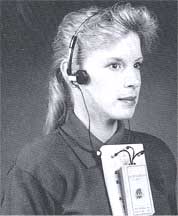
Hearing by Ear Stethoscope Sonography
It's easy to see why the sonograph is an accurate method of capturing and analyzing these significant sounds.
The test takes but a few minutes and you will wear a headset that looks similar to that of a small portable radio while you open and close your mouth several times. The sensors over both of your jaw joints capture the sound vibrations and they are recorded in the computer for later study.
When sounds occur as you open or close your mouth, how loud the sound is, and whether it is a soft or sharp sound, all have specific meaning to the doctor. Sonography is not only a diagnostic tool. It may also be used to monitor the course of treatment.
